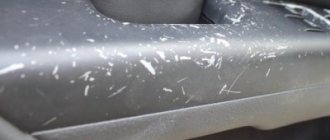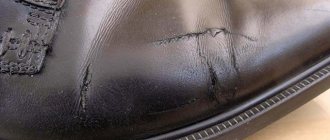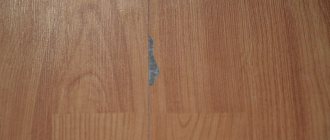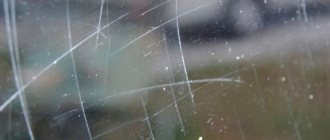Plastic, or plastic, is a common material based on natural and synthetic polymers.
It does not have high strength; mechanical stress on it leads to unwanted damage - scratches and cracks of varying depths.
This does not mean that the product is completely damaged. There are several ways to remove a defect or carefully disguise it.
We will tell you in this article how and what you can use to remove scratches from plastic (transparent, black, matte, etc.).
Causes of plastic damage
This is an elastic but fragile material, so it scratches easily. Sometimes any inaccurate movement, mechanical impact or friction causes damage.
Plastic window sills, plastic displays and housings of gadgets that are carried in pockets, car panels where large objects are carried, and plastic headlights into which sand and asphalt chips fly are often scratched. Small cracks can be repaired on your own; deeper damage will require professional restoration.
How to remove minor scratches
Small cracks in plastic can be painted over, filled with a solid substance, or sanded using various means. Let's consider each method in detail.
Polish
The polish removes scratches and cracks from matte and glossy plastic. Before use, clean and degrease the surface with alcohol or acetone. Apply polish to a soft cloth and rub gently into the scratch without pressing. Let the product dry and then polish until shiny with a dry cloth.
Do not use polish with abrasive particles - they will scratch the plastic even more.
Wax
Soft wax fills voids and smoothes the surface of the object. Clean and degrease the plastic and apply wax to the scratch. Using a soft microfiber cloth, rub the wax into the scratch and wipe off any excess with a cotton pad. You can also use a wax pencil, which you can buy at a hardware store.
Goi paste works in a similar way - it is a means of grinding and polishing hard plastics, polymers, ceramics and metals. The paste removes almost all scratches on plastic. When using this product, proceed in the same way as with wax.
Hairdryer
Plastic has a low melting point and the scratch can be carefully melted with a hair dryer. Clean and degrease the surface and direct hot air at the crack, moving up and down the entire scratch.
Be careful: if you blow a hairdryer on a scratch for a long time, the plastic may melt and the surface will become deformed. Leave to cool for 15-20 minutes and then wipe the item with a cloth.
Lighter
If the scratch is small, you can use a lighter instead of a hairdryer. Clean the surface and warm the scratch with a lighter. Then remove any remaining soot by wiping the surface with a cotton pad soaked in alcohol. Temperature methods require skills, so if you are planning to restore a valuable item, it is better to turn to professionals.
Restorative pencils
There are special pencils that paint over scratches on plastic - they will mask small and shallow damage. To paint over a scratch, you need to carefully choose the shade of the pencil, otherwise the crack will stand out.
Clean and degrease the plastic, and then carefully paint over the scratch with a pencil. Let dry and remove excess product.
other methods
There are other methods of processing plastic surfaces that are used everywhere. These methods have been tested in practice, so their effectiveness is beyond doubt.
Polishing plastic with a grinding wheel
A common method used in specialized workshops. Suitable for cases where you have access to a grinding wheel and need to process a plastic part in a hurry. The grinding wheel provides quick polishing, but the finish is rough and suitable for exceptional cases. For example, it will be extremely difficult to polish the lenses of safety glasses or similar products with a characteristic curve and many small parts.
In most cases, the grinding wheel is used when processing large parts that have a slight bend. An example would be a car bumper, which is polished during auto body repair before painting.
Using toothpaste
Amazingly, toothpaste is actually suitable for polishing plastic surfaces. This method is so effective that car mechanics use it to polish headlights: the surface becomes perfectly smooth, as if it had just come off the factory assembly line. Polishing toothpaste takes a little more time than using an abrasive compound. However, the method is quite effective, not to mention the low cost.
Sanding headlights with toothpaste
Heat treatment
Chips, abrasions and other defects are the result of rough mechanical impact. Heat treatment helps melt sharp edges. The plastic gradually melts, grows together, becoming transparent again. This method is quite complicated and requires certain skills. Be careful as improper use may result in damage to the product.
Polishing
Polish and similar compounds are great for working with soft materials and pliable surfaces. Their only drawback is their high cost. That is why they are used mostly in the professional sphere. However, if you need to restore the transparency of any important part of a car or household appliance, you can use a polish. The effect will not take long to appear.
Most of the above methods are quite simple, and, most importantly, do not require special training or expensive materials. Try them out and be sure to share your results in the comments below this article.
Traditional methods of getting rid of scratches
You can remove scratches from the plastic display of your phone using folk remedies, such as toothpaste. Clean the surface of the object, rub toothpaste into the scratch in a circular motion and leave for 2-3 minutes. Then wipe off the excess with a soft cloth. The method is used for plastic phone screens and gadget cases.
The abrasive parts of baking soda work similarly to toothpaste—filling cracks and smoothing the surface—but baking soda can only be used on hard plastic. Mix baking soda with water in a 1:2 ratio and rub into the scratch in a circular motion. Then polish the surface with a soft cloth.
Toothpaste and baking soda are not suitable for removing deep scratches.
How to get rid of deep marks
You can remove deep marks using sandpaper or a special product. Sandpaper is suitable for sanding and polishing scratches, but should not be used on glossy plastic surfaces. Matte plastic of window sills and car interiors must be handled carefully.
Before starting treatment, wipe the item with alcohol. To get rid of a crack, take 800-grit sandpaper and sand the scratch in a circular motion until the defect disappears. Then wipe with a damp and dry cloth.
You can use Displex scratch remover paste. The product removes large and deep scratches: it contains plastic microparticles that will fill the damage. Apply the paste to a cotton pad and rub into the damaged area for 2-3 minutes. If the crack does not disappear, repeat. Then remove any excess Displex and wipe the plastic with a dry cloth.
Liquid plastic can help repair heavily damaged surfaces, but it must be identical to the base material of the surface. Gently rub the liquid plastic into the scratch and let it harden. Then apply polish.
Subtleties of the process
When it becomes necessary to work with your own hands, you always have to take responsibility for the final result. It’s one thing if you have to carry out such work for yourself, but the question is completely different if this procedure is performed for the owner of another car.
In this regard, it is necessary not only to choose the polish correctly, but also to carry out the work in such a way as not to spoil the glass surface, which is sensitive to damage, and at the same time achieve an effect that will satisfy all the requirements.
The circle that will serve as an attachment for a drill or machine is a special device that is sold exclusively in car dealerships and is designed to allow you to polish a certain type of surface.
Such circles can have different grain sizes: this is necessary in order to speed up the time required to carry out the work and achieve a more worthwhile effect. For this purpose, manufacturers offer to purchase ready-made kits for processing the glass surfaces of headlights. Typically, such a set includes from 3 to 5 wheels with different grain sizes - from the coarsest to fine enough for fine grinding.
To get started, you first need to clean the glass from dirt and traces of insects, if necessary. Then a layer of polish is applied to the surface to be treated, and gradual processing of the headlight glass using a drill begins.
By gradually changing the circle to a finer-grained one, in the end you can achieve the expected effect
At the same time, it is important not to overdo it with the speed of rotation of the circle, because if it is excessive, you can damage the glass surface and make it unsuitable for further use
Features of eliminating scratches on different types of plastic
Choose a scratch remover depending on the color and structure of the plastic. Let's look at the most popular methods of removing damage.
Transparent
Scratches on transparent plastic are more noticeable than on matte and colored ones. Do not use hard or metal brushes or aggressive household chemicals when processing - this will harm plastic items.
How to remove scratches from clear plastic: To do this, use jewelry polish and glass cleaning fluid. Apply one of the products to a microfiber cloth, thoroughly treat the plastic and wipe with a damp cloth.
Matt
To mask the damage, you can sand the surface with fine-grained sandpaper. For a colored matte surface, use special correctors and markers, and for a black surface, use charcoal powder or shoe polish.
White and colored
Cracks in the white plastic are almost invisible, but they become clogged with dust. To remove a scratch on a white surface, sand it with 600-grit sandpaper.
On black and colored plastic, cracks are removed with a special corrector pencil.
Restoring headlight glass from the inside
In some cases, headlight polishing may be required not only on the outside, but also on the inside. For example, a similar situation often arises when using a depressurized headlight, or if xenon lamps are used as lighting elements. The principle of polishing is absolutely the same as on the outside, the only thing is that in this case you cannot do without removing the headlight.
Since the glass is glued with a sealant, you will need a hair dryer to dismantle it. With this device you need to heat the glass surface to 70-80 degrees
Heating should be done very carefully so as not to overheat the glass, as it may crack or “float”. After heating, the sealant will soften and the glass can be easily removed, the only thing is that you need to have time to disassemble the headlight before the glass cools down
At the same time, you should not pry it with a screwdriver so as not to damage it.
When polishing internal headlights, be extremely careful not to damage the lighting fixture.
After polishing the glass, it needs to be installed in place. To do this, use a special sealant for headlights, for example, Abro WS-904.
How to remove scratches from plastic in a car
When cleaning, do not use aggressive or degreasing agents, as they will lead to new damage. You can hide small scratches on the plastic in your car using a wiping towel or a corrector pencil. Wax pencils give an immediate effect, but over time the scratch will have to be painted over again.
For complex and deep scratches, use special polishes. There are special tools for processing all types of plastic: from matte to transparent. Try Sonax and Star Brite car cosmetics - the products will remove scratches without traces of polishing.
If a plastic part is severely scratched and cannot be replaced, it can be repaired. Gently sand the surface with fine-grained sandpaper, clean the surface from dust and prime. Then the plastic needs to be puttied, leveled and painted. If necessary, it can be varnished.
Polishing
It is worth noting that polishes do not protect against moisture and water. Over time, they simply wash off. Therefore, if tarnishing of the plastic is noticed some time after treatment with polish, the surfaces should be wiped of dirt and re-coated with the substance. This approach will avoid the appearance of new defects and preserve the shine of the product for a long time.
How to remove scratches on a plastic window sill
Dust and dirt get into the scratches of the window sill - cracks spoil the appearance of the surface and destroy it. Simple methods will not help here; serious repairs are needed.
How to remove scratches:
- Liquid plastic Cosmofen. Choose a product depending on the type of damage: the deeper the scratch, the larger the size of the plastic microparticles should be. First, test the effect of liquid plastic on a small area of the window sill and strictly follow the instructions.
- Laminated film. If there are a lot of scratches on the windowsill, use film. First, putty and level the surface, and then carefully spread the film, piercing the resulting air bubbles with a needle. Use a hot air gun to secure the film. This method of removing scratches is best left to a specialist.
- PVC gaskets. The method is similar to using laminated film. Scratches are sealed with PVC gaskets and blown with a hot air gun.
Before removing cracks, be sure to wash and degrease the surface.
Let's sum it up
When choosing which polish is best for bumpers against scratches, you should take into account the ratio of its quality and cost. Budget formulations are more economical, but do not provide a good polishing effect and do not hide damage. But, regardless of the price, the polish must be used regularly, otherwise the effect will be short-lived. Constant use of the composition maintains the attractive appearance of the car and protects plastic elements from the harmful effects of external factors.
Source











